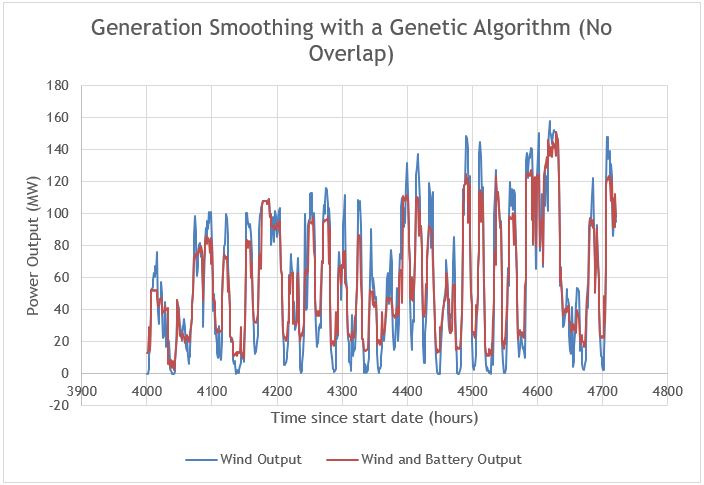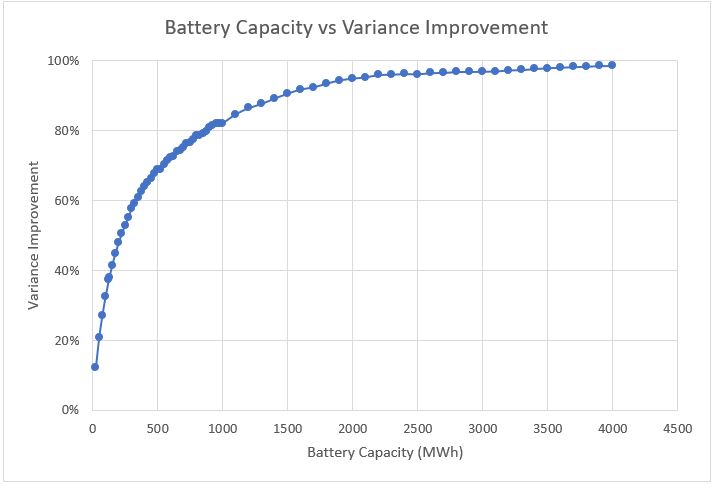Projects:2017s1-140 Energy Storage Requirements for the SA Grid
Contents
Introduction
Project Description
Project 140 - Energy Storage Requirements for the SA Grid
The aim of this project is to determine the requirements for energy storage in South Australia, so that the power generated in renewable energy generation may be delivered to consumers consistently and reliably. This is explored by the development of software tools and a database, to obtain, store and maintain energy data. The potential uses of this database is explored, both how it can be used broadly, and how it can be used in the context this project. Finally, a case study is undertaken in which the obtained data is used to explore the effect of battery storage on the output of a wind farm; and how intelligently managing the battery energy storage system can improve results.
Project Group Members
- Daniel Bondarenko
- Ryan Standing
Project Supervisors
- Professor Derek Abbott
- Mr David Vowles
Aim and Motivation
Renewable energy sources are becoming increasingly prevalent in South Australia. Although having many benefits, they also have their drawbacks. Chief among these is their intermittency.
Intermittency refers to the fact that renewable energy sources vary in intensity, depending on the time of day or season of the year, to the point that they are unable to provide continuous, reliable energy generation on their own. Renewable energy sources are also unable to respond dynamically to changes in demand as renewable energy generators are totally reliant on the energy that nature can provide at that moment.
In order to alleviate the intermittency inherent in renewable generators, energy storage systems such as batteries and pumped-hydro can be used. These storage systems are used to store energy when renewable generators are producing more energy than there is demand for. As such, when energy generation falls below demand, the energy stored in the energy storage systems is used to meet demand.
Method
In order to explore an energy storage solution, a package of software tools was created. These tools enable data to be intuitively and automatically downloaded (initially from AEMO, but is expandable to other sources), formed into a dataset, and manipulated and used to form smaller datasets and plots.
Once this data had been obtained, it was decided to perform a case study to preliminarily explore the effect of energy storage on renewable generation output in SA. For the study, generation data from the Hornsdale wind farm was used to investigate the use of a battery energy storage system to minimise the output variance of the wind generators at Hornsdale. The battery currently being constructed by Tesla at the Hornsdale site will be modelled, to explore the effect that a soon-to-be existing battery can have on smoothing the wind generation output of a generation site.
Methods of controlling the charging and discharging of the battery were explored. These involved the use of genetic algorithms. Genetic algorithms are a type of search algorithm which aim to solve optimisation problems by using the mechanisms of natural selection and population genetics.
Results
Using a genetic algorithm to manage the charging and discharging of battery with the same specifications as the Tesla battery (129MWhr capacity and 100MW output) yielded an improvement of 38.31% in the variance when compared to the raw generation data. This is also a 10.55% improvement over managing the battery using a basic, constraint-based algorithm. Therefore, utilising a battery energy storage system that will soon be a part of the SA energy network can provide a notable benefit if used in this way. A plot of the raw generation data compared with the generation output with a battery utilising genetic algorithm management is shown below.
The amount of battery energy storage necessary to produce a specified reduction in variance was also explored. Using the same method of battery management as used in the plot above, various battery sizes were explored and plotted below.
As seen in the figure above, in order to improve the variance of the generation data by a reasonable measure of 90%, a storage system with a capacity of 1500MWh is required. Beyond this point, the benefits of improved variance require increasingly higher capacities for the same proportion of improvement.
Conclusions
The database developed during the course of this project contains an abundance of useful data that can be used in many useful ways. In the case study, it was found to be useable and useful; both in its ability to update data, and access and use data. It was also found to be easily expandable during the project, and will serve as a useful tool for energy research in the National Energy Market into the future.
The case study of battery storage attached to the Hornsdale wind farm has shown promising results, with improvements in the variance of wind generation of up to 38.31% across a 29-day period with the use of a battery. The use of genetic algorithms to accomplish this, although little explored in this field, has produced the aforementioned results. Due to their usability, as experienced in this project, and the results they have produced, genetic algorithms have shown to be promising in optimising the management of battery energy storage systems.
Future Work
From the groundwork laid during this project, and the promise of the options explored, it is believed that much will be gained by further exploration into this topic. Using the database produced in this year’s iteration of the project, the use of genetic algorithms in the management of battery energy storage systems can be explored further. The analysis of the effectiveness of battery energy storage using genetic algorithms can be improved in future by randomising generation data to better reflect a forecast; or using actual forecast data obtained from AEMO through the software tools. Accounting for charge and discharge rates in the batteries used in energy storage will also improve the analysis. An area into which to extend this year’s work is to use genetic algorithms to manage battery energy storage systems to follow energy demand, rather than to minimise variance. This has the potential to provide real benefit if successful.

